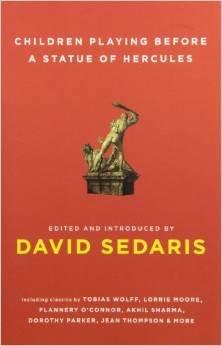Book Review of David Sedaris’ Children Playing Before a Statue of Hercules
The first time I read David Sedaris I instantly fell in love with his writing. I was reading Me Talk Pretty One Day, and when I finished, I could not wait to get my hands on another one of his books. Next was Naked, and then When Engulfed in Flames, and I didn’t stop until I read everything he’s written. Those three collections of his short stories are my favorites, and they make me laugh out loud imagining his life experiences. I love his wit and humor, and his ability to tell stories so incredibly well. This book, Children Playing Before a Statue of Hercules, isn’t written by David Sedaris; instead, it is a collection of his favorite short stories by his favorite writers (authors who influenced him to become a short story writer himself). Since I love his style, I knew I would love his taste. This collection is so rich and wonderful, and I felt like every story was a treat. It ranges in emotional appeal from humorous to morbid, and a story or two definitely brought me to tears. It is a wonderful variety of excellent writing – and the great thing about short stories is that they are easy to read in a sitting, and if you don’t like one, you can skip it and move on to the next. However, I felt that all of David’s picks were thoroughly entertaining, if only because of how well written they are. I strongly suggest reading it if you’re looking for something really interesting and diverse.
A special note about purchasing this collection is that the proceeds go to a nonprofit organization called 826NYC, which is dedicated to helping young students ages 6 to 18 develop writing skills. The book’s epilogue, written by Sarah Vowell, discusses 826NYC’s efforts including tutoring, writing workshops, assistance with school publications and with homework, and other free, educational events. The organization is hidden behind the storefront of Brooklyn Superhero Supply Co., which draws in many of the students that end up seeking help from 826. In addition, every cape and utility belt bought at the Superhero Supply Co. directly supports 826NYC, and the coolest part about it is that a secret door separates the store from the writing lab (very Scooby Doo bookshelf trap door if you ask me). How much better does it get when you buy a book? Amazing stories AND the benefit of helping kids. Buy this book. Have I convinced you?
Stories included in Children Playing:
- Introduction by David Sedaris
- “Oh, Joseph, I’m So Tired” by Richard Yates
- “Gryphon” by Charles Baxter
- “Interpreter of Maladies” by Jhumpa Lahiri
- “The Garden Party” by Katherine Mansfield
- “Half A Grapefruit” by Alice Munro
- “Applause, Applause” by Jean Thompson
- “I Know What I’m Doing About All the Attention I’ve Been Getting” by Frank Gannon
- “Where the Door Is Always Open and the Welcome Mat Is Out” by Patricia Highsmith
- “The Best of Betty” by Jincy Willett
- “Song of the Shirt, 1941” by Dorothy Parker
- “The Girl with the Blackened Eye” by Joyce Carol Oates
- “People Like That Are the Only People Here: Canonical Babbling in Peed Onk” by Lorrie Moore
- “Revelation” by Flannery O’Connor
- “In the Cemetery Where Al Jolson Is Buried” by Amy Hempel
- “Cosmopolitan” by Akhil Sharma
- “Irish Girl” by Tim Johnston
- “Bullet in the Brain” by Tobias Wolff
- Epilogue by Sarah Vowell
If you’re wondering about the name of this collection, David was inspired by a painting of the same name by Adriaen van der Werff in 1687. He said he felt like a small speck at the foot of his awesome writing heroes, trying to accomplish a fraction of what they have done. Here’s what the painting looks like, and you can see the same statue on the cover of the book:
Excerpt from David Sedaris’ Introduction: “When apple-picking season ended, I got a job in a packing plant and gravitated toward short stories, which I could read during my break and reflect upon for the remainder of my shift. A good one would take me out of myself and then stuff me back in, outsized, now, and uneasy with the fit. This led to a kind of trance that made the dullest work, the dullest life, bearable.” He also states his belief that “stories can save you.” I think David Sedaris is one of the best modern writers of the most up-and-coming genre of literature, the short story cycle. I hope to meet him some day; I like to imagine that we could be great friends, talking over coffee and laughing at each other’s anecdotes. For now, I am the child bowing at his feet and raving about his work, spreading the love of one my favorite authors.
Chelsea
Picture of Children Playing Before a Statue of Hercules




